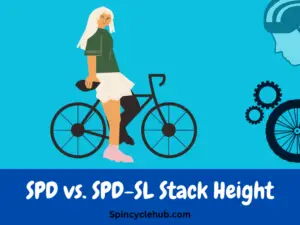Introduction
Cycling enthusiasts are well aware of the importance of choosing the right pedals for their rides. One factor that often comes into consideration is the stack height of the pedals. In this article, we’ll dive into the comparison between SPD (Shimano Pedaling Dynamics) and SPD-SL (Shimano Pedaling Dynamics – Super Light) stack heights, exploring their differences and helping you make an informed decision.
Understanding Stack Height
Before we delve into the specifics of SPD and SPD-SL stack heights, let’s first understand what stack height actually means. In cycling, stack height refers to the distance between the pedal axle and the sole of your cycling shoe when clipped into the pedal. It plays a crucial role in achieving an efficient and comfortable riding experience.
The SPD Stack Height
SPD pedals are widely popular among mountain bikers, commuters, and cyclists who prioritize versatility and ease of use. The stack height of SPD pedals tends to be lower compared to SPD-SL pedals. The reason behind this is that SPD pedals are designed to be recessed into the sole of compatible cycling shoes, allowing for more walking comfort when off the bike.
Benefits of Low Stack Height (Anecdote)
I vividly remember my first cycling tour, equipped with SPD pedals. The lower stack height not only provided me with a more natural and efficient pedaling motion but also offered a sense of stability and confidence on the bike. Moreover, when I had to dismount and walk a steep trail or explore a picturesque town, the recessed cleats made it incredibly comfortable to walk, saving me from any awkward moments.
The SPD-SL Stack Height
On the other hand, SPD-SL pedals are primarily designed for road cycling and racing, where maximizing power transfer and pedaling efficiency are paramount. The stack height of SPD-SL pedals tends to be higher compared to SPD pedals. This higher stack height allows for a direct connection between the shoe and the pedal, minimizing any potential power loss during the pedal stroke.
Benefits of Higher Stack Height (Anecdote)
When I switched to SPD-SL pedals for my road bike, I immediately noticed the difference in stack height. The increased height provided a noticeable improvement in power transfer, allowing me to transfer every ounce of energy efficiently to the bike. The direct connection between the pedal and the shoe also gave me a more stable and locked-in feeling during sprints and fast descents.
Factors to Consider
When choosing between SPD and SPD-SL pedals based on stack height, there are a few factors to consider:
Riding Style and Terrain
Your riding style and the terrain you typically encounter should play a significant role in your decision-making process. If you’re an avid mountain biker or commuter who frequently needs to walk off the bike, the lower stack height of SPD pedals might be more suitable. On the other hand, if you’re primarily a road cyclist or racer looking for optimal power transfer, the higher stack height of SPD-SL pedals could be the better choice.
Shoe Compatibility
Stack height is not the only consideration; shoe compatibility is equally important. Make sure your cycling shoes are compatible with the pedal system you choose. SPD and SPD-SL shoes have specific cleat patterns and bolt holes that match their respective pedals. Ensuring compatibility will allow you to take full advantage of the stack height benefits.
Personal Preference
Lastly, personal preference should never be overlooked. Some riders may prioritize walking comfort and versatility, while others may prioritize maximum power transfer. Consider your own preferences and riding goals when making a decision. It’s all about finding the right balance that suits your needs and enhances your cycling experience.

Conclusion
In the battle of stack heights, both SPD and SPD-SL pedals have their own unique advantages. SPD pedals with their lower stack height offer versatility, comfort, and ease of walking, making them ideal for mountain biking and commuting. On the other hand, SPD-SL pedals with their higher stack height prioritize power transfer, making them the go-to choice for road cyclists and racers.
Remember to assess your riding style, terrain, shoe compatibility, and personal preferences before making a decision. Ultimately, the right choice depends on finding the pedals that align with your specific needs and enhance your enjoyment on two wheels.
FAQs:
Q1: Can I use SPD pedals for road cycling?
A1: While SPD pedals can technically be used for road cycling, they are not as common or recommended for high-performance road cycling. SPD-SL pedals are more suited for that purpose due to their higher stack height and optimized power transfer.
Q2: Are SPD-SL pedals compatible with mountain bike shoes?
A2: No, SPD-SL pedals are not compatible with mountain bike shoes. They require specific road cycling shoes with the corresponding cleat pattern and bolt holes.
Q3: Can I walk comfortably with SPD-SL cleats on my shoes?
A3: Walking with SPD-SL cleats can be challenging due to their larger size and protrusion. The higher stack height of SPD-SL pedals is optimized for cycling efficiency rather than walking comfort.
Q4: Are there any disadvantages to a lower stack height?
A4: While a lower stack height provides benefits such as walking comfort and versatility, it may sacrifice some power transfer and efficiency compared to higher stack heights.
Q5: Can I use the same shoes for both SPD and SPD-SL pedals?
A5: No, SPD and SPD-SL pedals require different cleat patterns and bolt holes. You will need specific cycling shoes for each pedal system.
Watch this one,
Video Credits – West Point Cycles
DOWNLOAD THIS ARTICLE : SPD vs. SPD-SL Stack Height
You May Also Like
- 1988 Schwinn World Sport: A Classic Ride That Stands the Test of Time
- Exploring the Fun and Convenience of Adult Tag Along Bikes
- Schwinn Serial Numbers Japan: Decoding the Secrets of Vintage Bikes
- Timberline All GT Terra: Your Ultimate Off-Road Adventure Companion




